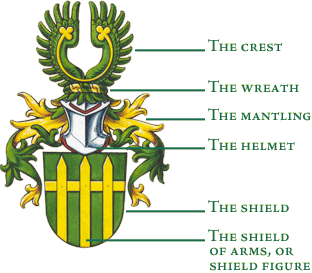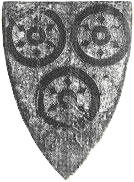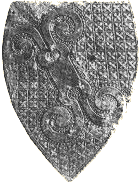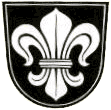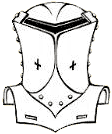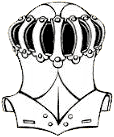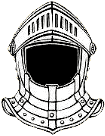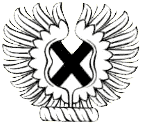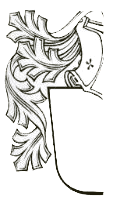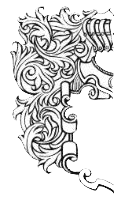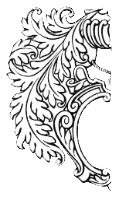The essential components of a coat of arms
A full achievement of arms comprises the following components:
The shield as part of a coat of arms was adopted from the equipment of a knight. As the central part of a coat of arms, it displays the heraldic figure and gives the coat of arms its particular outer form. As a rule, the shield will contain a single tincture or a single motif; it may however also be divided into combinations of parted and varied fields containing several heraldic figures or symbols.
The horseman’s shield of the High Middle Ages was developed on the pattern of the so-called ‘Norman’ shield, a kite-shaped shield of the 11th century. ‘Norman’ shields were relatively big shields, long and narrow; they had rounded tops. Already around 1200 this Romanesque shield, with its form comparable to an almond, was replaced by the Gothic and triangular shield known as heater shield. This new shield was significantly smaller, easier to handle, and permitted greater freedom of movement.
About 1360 the Spanish semi-circular shield came into more widespread use. Its pleasant shape and its large surface allowed for a generous layout of fields, especially so for coats of arms with several figures or symbols, or for coats of arms with parted and varied fields.
The helmet as a heraldic device was also taken over from the equipment of a knight. Its presentation did not have a deeper meaning, except that different types of helm were assigned to armigers of different ranks. In Germany, the use of a tilting helm was restricted to the coat of arms of citizens, a mêlée helm was used in the coat of arms of the lesser nobility, and barriers helms were depicted in the coat of arms of the great magnates.
The wreath which separates the crest from the mantling was a merely ornamental device with no armorial significance. A crest coronet (an ornamental circlet which could be used in place of the wreath) might also be used as a coronet of rank though this was not necessarily so.
The crest which developed from armorial devices used in tournaments, is the distinctive mark of an individual. There was great freedom of choice with regard to its design, though feathers of any kind were not considered a genuine crest. The device has to be clear and concise, but it should not have a stronger effect than the shield.
The mantling or lambrequin probably originated during the Crusades as a protective cloth worn to absorb the sun’s heat so that helmets did not become too hot; it has a decorative function and no particular armorial significance. Initially, the mantling displayed simple ornaments which still underlined its original function. When during the period of ‘living’ armory further developments set it, mantlings changed via a more elaborate, sumptuous and Gothic display of stylized tassels, ribbons or interlaced patterns flowing from beneath the crest, into purely decorative devices.
The proportions of the components of a coat of arms is 3 (shield) to 2 (helmet) to 3 (crest). Modern armory adopted the harmonic proportions of the late Gothic era (c.1500). The middle of the helmet is seen as the centre of the full achievement of arms.
(We would like to take this opportunity to express our thanks to Professor Wilhelm Busse of the Chair of Medieval English Literature and Historical Linguistics at the University of Düsseldorf in Germany for his kind support in translating this text and possible supplements.)
